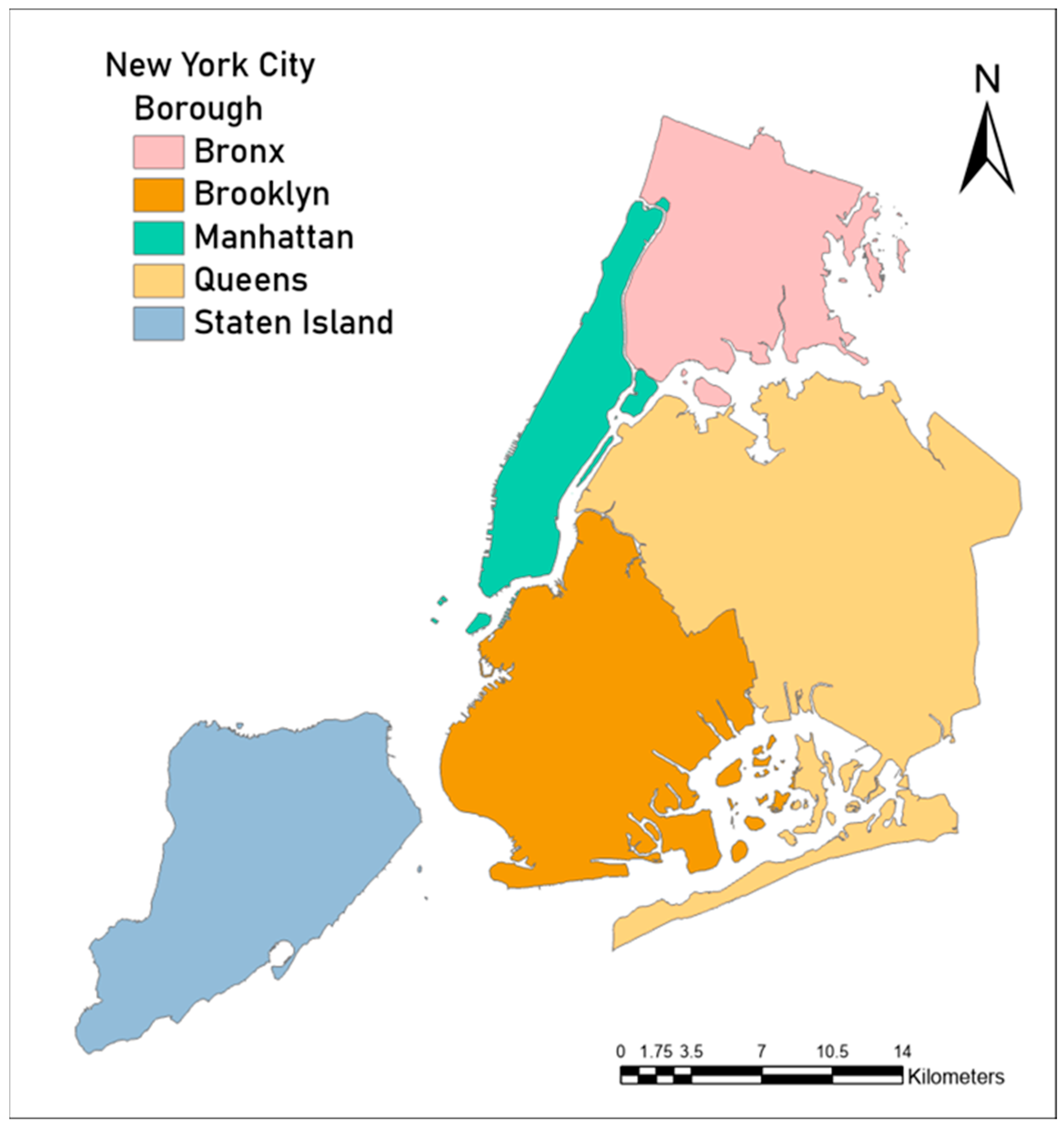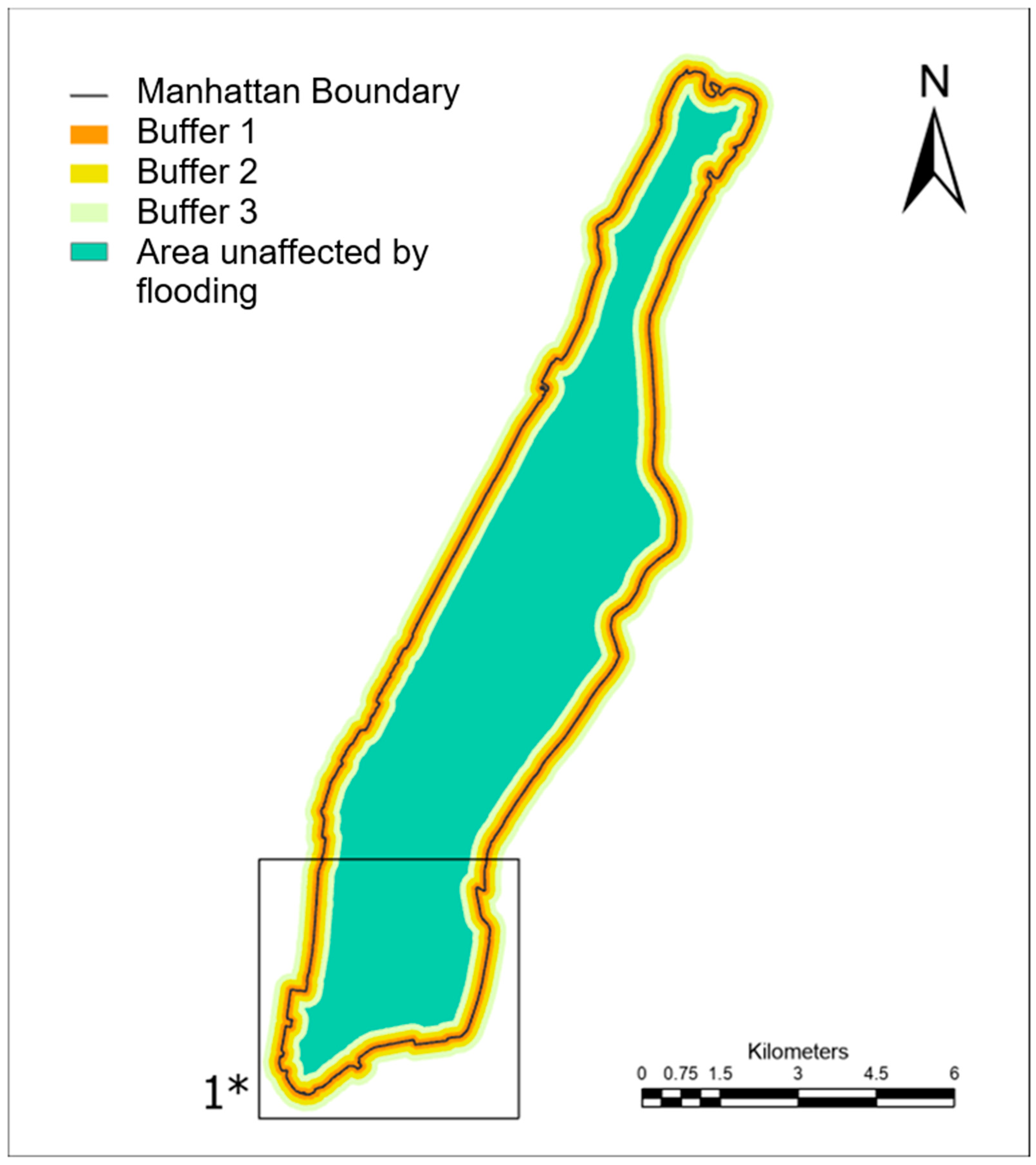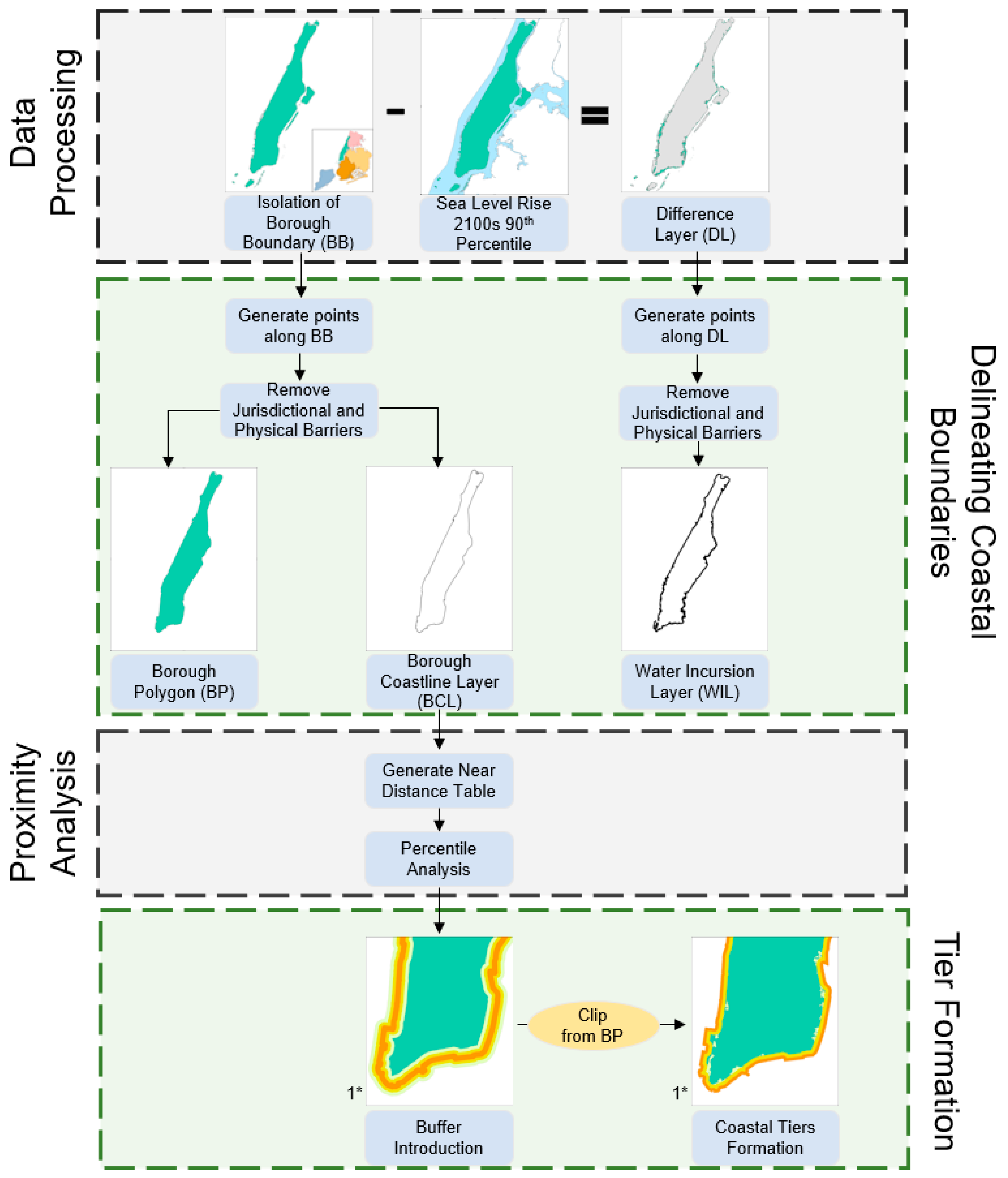Building Urban Forest Resilience to Sea Level Rise: A GIS-Based Climate Adaptation Tool for New York City
Abstract
1. Introduction
2. Materials and Methods
2.1. Study Area
2.2. Coastal Vulnerability Factors
2.3. Species Tolerance to Coastal Vulnerability Factors
2.4. Coastal Tiers
2.4.1. Sea Level Rise Data Processing
2.4.2. Coastal Boundary Delineation
2.4.3. Proximity Analysis
2.4.4. Coastal Tier Formation
3. Results
3.1. Species Palette
3.2. Coastal Tiers
4. Discussion and Management Implications
5. Conclusions
Supplementary Materials
Author Contributions
Funding
Data Availability Statement
Acknowledgments
Conflicts of Interest
References
- Burkhard, B.; Kroll, F.; Nedkov, S.; Müller, F. Mapping Ecosystem Service Supply, Demand and Budgets. Ecol. Indic. 2012, 21, 17–29. [Google Scholar] [CrossRef]
- Rosenzweig, C.; Solecki, W. The Future We Don’t Want: How Climate Change Could Impact the World’s Greatest Cities; C40 Cities Secretariat: London, UK, 2018. [Google Scholar]
- Hanson, S.; Nicholls, R.; Ranger, N.; Hallegatte, S.; Corfee-Morlot, J.; Herweijer, C.; Chateau, J. A Global Ranking of Port Cities with High Exposure to Climate Extremes. Clim. Chang. 2011, 104, 89–111. [Google Scholar] [CrossRef]
- Hallett, R.; Johnson, M.L.; Sonti, N.F. Assessing the Tree Health Impacts of Salt Water Flooding in Coastal Cities: A Case Study in New York City. Landsc. Urban Plan. 2018, 177, 171–177. [Google Scholar] [CrossRef]
- Hallegatte, S.; Green, C.; Nicholls, R.J.; Corfee-Morlot, J. Future Flood Losses in Major Coastal Cities. Nat. Clim. Chang. 2013, 3, 802–806. [Google Scholar] [CrossRef]
- Dmuchowski, W.; Brągoszewska, P.; Gozdowski, D.; Baczewska-Dąbrowska, A.H.; Chojnacki, T.; Jozwiak, A.; Swiezewska, E.; Suwara, I.; Gworek, B. Strategies of Urban Trees for Mitigating Salt Stress: A Case Study of Eight Plant Species. Trees 2022, 36, 899–914. [Google Scholar] [CrossRef]
- Laffray, X.; Alaoui-Sehmer, L.; Bourioug, M.; Bourgeade, P.; Alaoui-Sossé, B.; Aleya, L. Effects of Sodium Chloride Salinity on Ecophysiological and Biochemical Parameters of Oak Seedlings (Quercus robur L.) from Use of de-Icing Salts for Winter Road Maintenance. Environ. Monit. Assess. 2018, 190, 266. [Google Scholar] [CrossRef]
- Plesa, I.; Hassan, M.A.; Sestras, A.F.; Vicente, O.; Boscaiu, M.; Sestras, R.E. Biochemical Markers of Salt Stress in European Larch (Larix decidua). Not. Sci. Biol. 2018, 10, 430–438. [Google Scholar] [CrossRef]
- Kozlowski, T.T. Responses of Woody Plants to Flooding and Salinity. Tree Physiol. 1997, 17, 490. [Google Scholar] [CrossRef]
- Allen, J.A.; Chambers, J.L.; Stine, M. Prospects for Increasing the Salt Tolerance of Forest Trees: A Review. Tree Physiol. 1994, 14, 843–853. [Google Scholar] [CrossRef]
- Paludan-Müller, G.; Saxe, H.; Pedersen, L.B.; Randrup, T.B. Differences in Salt Sensitivity of Four Deciduous Tree Species to Soil or Airborne Salt. Physiol. Plant. 2002, 114, 223–230. [Google Scholar] [CrossRef]
- Tully, K.; Gedan, K.; Epanchin-Niell, R.; Strong, A.; Bernhardt, E.S.; BenDor, T.; Mitchell, M.; Kominoski, J.; Jordan, T.E.; Neubauer, S.C.; et al. The Invisible Flood: The Chemistry, Ecology, and Social Implications of Coastal Saltwater Intrusion. BioScience 2019, 69, 368–378. [Google Scholar] [CrossRef]
- Doroski, D.A.; Ashton, M.S.; Duguid, M.C. The Future Urban Forest—A Survey of Tree Planting Programs in the Northeastern United States. Urban For. Urban Green. 2020, 55, 126816. [Google Scholar] [CrossRef]
- Shorris, A. Cool Neighborhoods NYC: A Comprehensive Approach to Keep Communities Safe in Extreme Heat; New York City Mayor’s Office: New York, NY, USA, 2017. [Google Scholar]
- Strauss, N. (NYC Department of Parks and Recreation, New York City, NY, USA). Personal communication, 2022.
- New York City Tree Map. Available online: https://tree-map.nycgovparks.org/ (accessed on 22 June 2022).
- Horton, R.; Little, C.; Gornitz, V.; Bader, D.; Oppenheimer, M. New York City Panel on Climate Change 2015 Report Chapter 2: Sea Level Rise and Coastal Storms. Ann. N. Y. Acad. Sci. 2015, 1336, 36–44. [Google Scholar] [CrossRef] [PubMed]
- Appleton, B.L.; Greene, V.; Smith, A.; French, S.; Kane, B.; Fox, L.J.; Downing, A.K.; Gilland, T. Trees and Shrubs That Tolerate Saline Soils and Salt Spray Drift; Communications and Marketing, College of Agriculture and Life Sciences, Virginia Polytechnic Institute and State University: Blacksburg, VA, USA, 2009. [Google Scholar]
- Duryea, M.; Kampf, E.; Littell, R. Hurricanes and the Urban Forest: I. Effects on Southeastern United States Coastal Plain Tree Species. Arboric. Urban For. 2007, 33, 83–97. [Google Scholar] [CrossRef]
- Matthews, S.N.; Iverson, L.R.; Prasad, A.M.; Peters, M.P.; Rodewald, P.G. Modifying Climate Change Habitat Models Using Tree Species-Specific Assessments of Model Uncertainty and Life History-Factors. For. Ecol. Manag. 2011, 262, 1460–1472. [Google Scholar] [CrossRef]
- NYC Open Data. Sandy Inundation Zone. 2022. Available online: https://data.cityofnewyork.us/browse?q=Sandy+Inundation+Zone&sortBy=relevance (accessed on 20 June 2022).
- NYC Open Data. Forestry Tree Points. 2022. Available online: https://data.cityofnewyork.us/Environment/Forestry-Tree-Points/hn5i-inap/data (accessed on 20 June 2022).
- NYC Open Data. Projected Sea Level Rise. 2022. Available online: https://data.cityofnewyork.us/City-Government/Projected-Sea-Level-Rise/6an6-9htp (accessed on 20 June 2022).
- NYC Open Data. Borough Boundaries. 2022. Available online: https://data.cityofnewyork.us/City-Government/Borough-Boundaries/tqmj-j8zm (accessed on 20 June 2022).
- Zhang, M.; Liu, Y.; Han, G.; Zhang, Y.; Wang, B.; Chen, M. Salt Tolerance Mechanisms in Trees: Research Progress. Trees 2021, 35, 717–730. [Google Scholar] [CrossRef]
- Czaja, M.; Kołton, A.; Muras, P. The Complex Issue of Urban Trees—Stress Factor Accumulation and Ecological Service Possibilities. Forests 2020, 11, 932. [Google Scholar] [CrossRef]
- Our Urban Forest. Available online: https://storymaps.arcgis.com/stories/5353de3dea91420faaa7faff0b32206b (accessed on 13 December 2023).
- Forest for All NYC. Available online: https://forestforall.nyc/ (accessed on 13 December 2023).
- Konijnendijk, C.C. Evidence-Based Guidelines for Greener, Healthier, More Resilient Neighbourhoods: Introducing the 3–30–300 Rule. J. For. Res. 2022, 34, 821–830. [Google Scholar] [CrossRef]
- Kabisch, N.; Frantzeskaki, N.; Pauleit, S.; Naumann, S.; Davis, M.; Artmann, M.; Haase, D.; Knapp, S.; Korn, H.; Stadler, J.; et al. Nature-Based Solutions to Climate Change Mitigation and Adaptation in Urban Areas: Perspectives on Indicators, Knowledge Gaps, Barriers, and Opportunities for Action. Ecol. Soc. 2016, 21, 39. [Google Scholar] [CrossRef]
- Powell, E.J.; Tyrrell, M.C.; Milliken, A.; Tirpak, J.M.; Staudinger, M.D. A Review of Coastal Management Approaches to Support the Integration of Ecological and Human Community Planning for Climate Change. J. Coast. Conserv. 2019, 23, 1–18. [Google Scholar] [CrossRef]
- Kim, M.; Song, K.; Chon, J. Key Coastal Landscape Patterns for Reducing Flood Vulnerability. Sci. Total Environ. 2021, 759, 143454. [Google Scholar] [CrossRef] [PubMed]
- Zhang, J. Coastal Saline Soil Rehabilitation and Utilization Based on Forestry Approaches in China; Springer: Berlin/Heidelberg, Germany, 2014; ISBN 978-3-642-39914-5. [Google Scholar]
- Campbell, L.K.; Svendsen, E.S.; Johnson, M.L.; Plitt, S. Not by Trees Alone: Centering Community in Urban Forestry. Landsc. Urban Plan. 2022, 224, 104445. [Google Scholar] [CrossRef]
- Zhou, B.; Rybski, D.; Kropp, J.P. The Role of City Size and Urban Form in the Surface Urban Heat Island. Sci. Rep. 2017, 7, 4791. [Google Scholar] [CrossRef] [PubMed]
- Krzyżaniak, M.; Świerk, D.; Antoszewski, P. Factors Influencing the Health Status of Trees in Parks and Forests of Urbanized Areas. Forests 2021, 12, 656. [Google Scholar] [CrossRef]
- Juráň, S.; Grace, J.; Urban, O. Temporal Changes in Ozone Concentrations and Their Impact on Vegetation. Atmosphere 2021, 12, 82. [Google Scholar] [CrossRef]
- Gilman, E.F.; Watson, D.G. Amelanchier canadensis: Shadblow Serviceberry. Available online: https://edis.ifas.ufl.edu/publication/ST074 (accessed on 13 December 2023).
- Gilman, E.F.; Watson, D.G. Amelanchier laevis: Allegheny Serviceberry. Available online: https://edis.ifas.ufl.edu/publication/ST075 (accessed on 13 December 2023).
- Shrubs for Difficult Sites. Cornell University|Cooperative Extension Monroe County. Available online: https://monroe.cce.cornell.edu/resources/shrubs-for-difficult-sites (accessed on 13 December 2023).
- Kushla, J. Storm-Resistant Trees for Mississippi Landscapes. Available online: https://extension.msstate.edu/publications/storm-resistant-trees-for-mississippi-landscapes (accessed on 13 December 2023).
- Fox, L.; Koci, J. Trees and Shrubs That Tolerate Saline Soils, Salt Spray and De-Icing Salts. Available online: https://www.pubs.ext.vt.edu/430/430-031/430-031.html (accessed on 13 December 2023).
- Betula populifolia: “Whitespire” (Asian White Birch, Japanese Gray Birch, Whitespire Japanese Birch)|North Carolina Extension Gardener Plant Toolbox. Available online: https://plants.ces.ncsu.edu/plants/betula-populifolia-whitespire/ (accessed on 13 December 2023).
- Salt Tolerant Plants. North Carolina Cooperative Extension. Available online: https://www.surfcitync.gov/DocumentCenter/View/54/Salt-Tolerant-Plants-PDF (accessed on 15 December 2023).
- Design and Planning for Flood Resiliency—Guidelines for NYC Parks. Available online: https://static.nycgovparks.org/images/pagefiles/128/NYCP-Design-and-Planning-Flood-Zone__5b0f0f5da8144.pdf (accessed on 13 December 2023).
- Duryea, M.L.; Kampf, E. Selecting Tropical and Subtropical Tree Species for Wind Resistance; EDIS 2007; University of Florida George A Smathers Libraries: Gainesville, FL, USA, 2007. [Google Scholar] [CrossRef]
- Duryea, M.L.; Kampf, E. Selecting Coastal Plain Species for Wind Resistance; IFAS Extension 2017; University of Florida: Gainesville, FL, USA, 2017. [Google Scholar]
- Gilman, E.F.; Watson, D.G.; Klein, R.W.; Koeser, A.K.; Hilbert, D.R.; McLean, D.C. Cornus florida: Flowering Dogwood. Available online: https://edis.ifas.ufl.edu/publication/ST185 (accessed on 13 December 2023).
- Jull, L.G. Winter Salt Injury and Salt-Tolerant Landscape Plants. Available online: https://hort.extension.wisc.edu/articles/winter-salt-injury-and-salt-tolerant-landscape-plants/ (accessed on 15 December 2023).
- Crataegus crus-galli: Cockspur Thorn, Cockspur Hawthorn, Dwarf Hawthorn PFAF Plant Database. Available online: https://pfaf.org/user/Plant.aspx?LatinName=Crataegus+crus-galli (accessed on 15 December 2023).
- Miyamoto, S.; Martinez, I.; Padilla, M.; Portillo, A.; Ornelas, D. Landscape Plant Lists for Salt Tolerance Assessment; Texas Agricultural Experiment Station: Austin, TX, USA, 2004. [Google Scholar]
- Gleditsia triacanthos. North Carolina State Extension. Available online: https://plants.ces.ncsu.edu/plants/gleditsia-triacanthos/ (accessed on 13 December 2023).
- Young, S.; Lamont, E.; Bustamante, V. Long Island Native Woody Plants for Landscaping and Restoration of Seaside Environments. Long Isl. Bot. Soc. 2016, 26, 16–17. [Google Scholar]
- Koelreuteria paniculata. Cornell University|Woody Plant Database. Available online: https://woodyplants.cals.cornell.edu/plant/131 (accessed on 13 December 2023).
- Gilman, E.F.; Watson, D.G. Malus spp.: Crabapple. Available online: https://hort.ifas.ufl.edu/database/documents/pdf/tree_fact_sheets/malsppa.pdf (accessed on 13 December 2023).
- Gilman, E.F.; Watson, D.G. Pinus parviflora: Japanese White Pine. Available online: https://hort.ifas.ufl.edu/trees/PINPARA.pdf (accessed on 15 December 2023).
- McKenzie, R. White Pine and Salt Tolerance. Available online: https://www.extension.purdue.edu/extmedia/fnr/fnr-faq-10-w.pdf (accessed on 17 December 2023).
- Gilman, E.F.; Watson, D.G. Pinus strobus: Eastern White Pine. Available online: https://edis.ifas.ufl.edu/publication/ST473 (accessed on 17 December 2023).
- Pinus sylvestris: Scots Pine, European Redwood. Available online: https://www.ebben.nl/en/treeebb/pisylves-pinus-sylvestris/pdf/ (accessed on 14 December 2023).
- Zencirkiran, M. Trends in Landscape, Agriculture, Forest and Natural Science; Cambridge Scholars Publishing: Newcastle upon Tyne, UK, 2019; ISBN 978-1-5275-4357-7. [Google Scholar]
- Gilman, E.F.; Watson, D.G. Quercus acutissima: Sawtooth Oak. Available online: https://edis.ifas.ufl.edu/publication/ST540 (accessed on 13 December 2023).
- Quercus acutissima: Sawtooth Oak. Available online: https://www.ebben.nl/en/treeebb/quacutis-quercus-acutissima/pdf/ (accessed on 13 December 2023).
- Shingle Oak Trees. Available online: https://www.midwestgardentips.com/trees-index-1/shingle-oak-trees (accessed on 13 December 2023).
- Quercus phellos. North Carolina State Extension. Available online: https://plants.ces.ncsu.edu/plants/quercus-phellos/ (accessed on 13 December 2023).
- Wind Resistance of Trees. Available online: https://blogs.ifas.ufl.edu/pinellasco/files/2018/03/wind-resistantance-of-trees.pdf (accessed on 13 December 2023).
- Species- Styphnolobium japonicum. Cornell University|Woody Plant Database. Available online: https://woodyplants.cals.cornell.edu/plant/234 (accessed on 13 December 2023).
- Gilman, E.F.; Watson, D.G.; Klein, R.W.; Koeser, A.K.; Hilbert, D.R.; McLean, D.C. Taxodium ascendens: Pondcypress. Available online: https://edis.ifas.ufl.edu/publication/ST619 (accessed on 13 December 2023).
- Landscape Plants—Zelkova serrata. Oregon State University. Available online: https://landscapeplants.oregonstate.edu/plants/zelkova-serrata (accessed on 13 December 2023).




| Tier | Description |
|---|---|
| 1 | Along the coastline, high exposure to high-speed winds, wind-driven salt spray, saltwater flooding, high likelihood of flooding in the event of sea level rise, only the most resilient tree species are suitable for planting. |
| 2 | Slightly inland, moderate exposure to high-speed winds, wind-driven salt spray, saltwater flooding, likelihood of flooding during sea level rise is lower than Tier 1, tree species with moderate tolerance to coastal factors are suitable for planting. |
| 3 | Farther inland, low to moderate exposure to high-speed winds, wind-driven salt spray, saltwater flooding, likelihood of flooding during sea level rise is minimal, tree species with low tolerance to coastal factors will thrive. |
| Distance from Coastline in Meters | |||
|---|---|---|---|
| Borough | Tier 1 | Tier 2 | Tier 3 |
| Bronx | 0.3–58.2 | 58.3–156.7 | 156.8–395 |
| Manhattan | 0.3–97.5 | 97.6–197.8 | 197.8–314.8 |
| Brooklyn and Queens | 0.3–176.4 | 176.5–412.0 | 412.1–651 |
| Staten Island | 0.3–205.1 | 205.2–794.6 | 794.7–1693 |
Disclaimer/Publisher’s Note: The statements, opinions and data contained in all publications are solely those of the individual author(s) and contributor(s) and not of MDPI and/or the editor(s). MDPI and/or the editor(s) disclaim responsibility for any injury to people or property resulting from any ideas, methods, instructions or products referred to in the content. |
© 2024 by the authors. Licensee MDPI, Basel, Switzerland. This article is an open access article distributed under the terms and conditions of the Creative Commons Attribution (CC BY) license (https://creativecommons.org/licenses/by/4.0/).
Share and Cite
Kaur, R.; Hallett, R.A.; Strauss, N. Building Urban Forest Resilience to Sea Level Rise: A GIS-Based Climate Adaptation Tool for New York City. Forests 2024, 15, 92. https://doi.org/10.3390/f15010092
Kaur R, Hallett RA, Strauss N. Building Urban Forest Resilience to Sea Level Rise: A GIS-Based Climate Adaptation Tool for New York City. Forests. 2024; 15(1):92. https://doi.org/10.3390/f15010092
Chicago/Turabian StyleKaur, Ravneet, Richard A. Hallett, and Navé Strauss. 2024. "Building Urban Forest Resilience to Sea Level Rise: A GIS-Based Climate Adaptation Tool for New York City" Forests 15, no. 1: 92. https://doi.org/10.3390/f15010092
APA StyleKaur, R., Hallett, R. A., & Strauss, N. (2024). Building Urban Forest Resilience to Sea Level Rise: A GIS-Based Climate Adaptation Tool for New York City. Forests, 15(1), 92. https://doi.org/10.3390/f15010092








